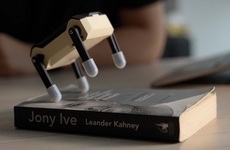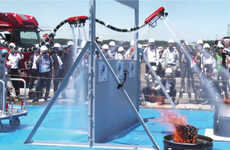
Robo-One Championships
Wessley Murylo — March 26, 2008 — Lifestyle
References: reuters
One by one the fighters are introduced into the ring at the Korakuen Stadium Hall in Tokyo, accompanied by thunderous applause. But this is no normal boxing match – the contenders are small humanoid robots built and controlled by hobbyists, participants in the twice-yearly “Robo-One Championshipsâ€.
Japan 'houses' 40% of all the robots in the world creating a fertile ground for amateur programmers, investing time and money in the designing and building of robots from in the market available components out of server motors, cameras, sensors and wires.
Last week more than 112 small remote controlled robots stepped into the ring to contest the championship. The competition shows a wide variety of warrior robots in all sizes and shapes. One is designed as Karate fighter, the other as a medieval prince or even as a fighting cock. By the end of the final day, 45 remained standing among the heavyweights (more than 3 kg) and featherweights (less than 3 kg).
The confrontation simulates the martial arts and reminds us of the hentai and manga animations in which robots play a dominant role. “Japanese children grow up seeing this type of animation and show therefore a lot of interest in robotsâ€, says the president of the organising committee, Terukazu Nishimura, “This competition transforms the animation into realityâ€.
Naoki Maru, a 41 year engineer and winner of the heavy-weights category this year, believes that the reluctance of the large companies to invest in the development of robots opens an opportunity to the hobbyists. “Many an advanced technology emerges during this type of disputing between robots. Take this competition, it is organised twice a year and in every edition an unbelievable revolution in robotics can been seen.â€
In the featherweight category, “Automo03-Sandan†– a robot dressed in karate gear – was no match for “Leghornâ€, a fighting cock known for its vicious Chicken Chop martial art moves. But in that category it was finally the South Korean robot Teakwon-V which crushed his opponents with fast punches, delighting his creator, Jeon Young Sun, who won the one million Yen premium (USD 10 mil) for that category. "It was a nice opportunity to see the Japanese robotic technology nearby.†said Jeon to Reuters.
In the final Maru's fighting robot "King Kaiser", winner of the heavy weight category, operated by his sons Kenta and Ryouma, defeated the winner of the feather weight Jeon's "Teakwon-V", and won the All Class title in which lightweights combat against heavyweights.
Enjoy the video
Video:
Japan 'houses' 40% of all the robots in the world creating a fertile ground for amateur programmers, investing time and money in the designing and building of robots from in the market available components out of server motors, cameras, sensors and wires.
Last week more than 112 small remote controlled robots stepped into the ring to contest the championship. The competition shows a wide variety of warrior robots in all sizes and shapes. One is designed as Karate fighter, the other as a medieval prince or even as a fighting cock. By the end of the final day, 45 remained standing among the heavyweights (more than 3 kg) and featherweights (less than 3 kg).
The confrontation simulates the martial arts and reminds us of the hentai and manga animations in which robots play a dominant role. “Japanese children grow up seeing this type of animation and show therefore a lot of interest in robotsâ€, says the president of the organising committee, Terukazu Nishimura, “This competition transforms the animation into realityâ€.
Naoki Maru, a 41 year engineer and winner of the heavy-weights category this year, believes that the reluctance of the large companies to invest in the development of robots opens an opportunity to the hobbyists. “Many an advanced technology emerges during this type of disputing between robots. Take this competition, it is organised twice a year and in every edition an unbelievable revolution in robotics can been seen.â€
In the featherweight category, “Automo03-Sandan†– a robot dressed in karate gear – was no match for “Leghornâ€, a fighting cock known for its vicious Chicken Chop martial art moves. But in that category it was finally the South Korean robot Teakwon-V which crushed his opponents with fast punches, delighting his creator, Jeon Young Sun, who won the one million Yen premium (USD 10 mil) for that category. "It was a nice opportunity to see the Japanese robotic technology nearby.†said Jeon to Reuters.
In the final Maru's fighting robot "King Kaiser", winner of the heavy weight category, operated by his sons Kenta and Ryouma, defeated the winner of the feather weight Jeon's "Teakwon-V", and won the All Class title in which lightweights combat against heavyweights.
Enjoy the video
Video:
Trend Themes
1. Robot Fighting Championship - A trend of promoting robot fighting championships can help develop new technologies in robotics for amusement and commercial purposes.
2. Amateur Robotics Community - A growing trend towards the development of an amateur robotics community can lead to the discovery of new and innovative robotic solutions.
3. Robotics for Childhood Education - A trend of using robots in childhood education can help generate interest and promote engagement in the field of robotics.
Industry Implications
1. Entertainment Industry - The entertainment industry can embrace the trend of robot fighting championships as a source of new and engaging content for audiences worldwide.
2. Robotics Industry - The robotics industry can foster and support the amateur robotics community to stimulate the exploration and innovation of new robotic technologies.
3. Education Industry - The education industry can incorporate robotics into their curriculum to promote interest in robots and technology from a young age.
2.7
Score
Popularity
Activity
Freshness






















